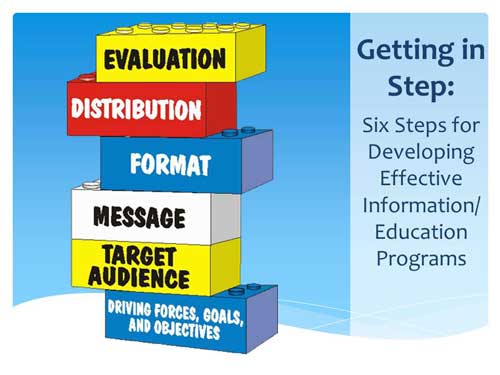Step 4: Design Implementation Program and Assemble the Watershed Plan (cont.)
Develop an Information/Education (I/E) Program
Because many water quality problems result from individual actions and the solutions are often voluntary practices, effective public involvement and participation promote the adoption of management practices, help to ensure the sustainability of the watershed management plan, and perhaps most important, encourage changes in behavior that will help to achieve your overall watershed goals. Following are six steps that will help you develop an effective I/E program. The steps are covered in even greater detail in the module Getting in Step: A Guide for Conducting Watershed Outreach Campaigns. The module is based on EPA's outreach guide Getting in Step: A Guide for Conducting Watershed Outreach Campaigns and on more than 100 outreach training workshops sponsored by EPA and others around the country.
In addition to the outreach guide, video, workshops, and training module, the Getting in Step outreach series includes a comprehensive stakeholder guide. Getting in Step: Engaging Stakeholders in Your Watershed (80 pp. 1.3 MB, about PDF files) presents the tools you need to effectively engage stakeholders to restore and maintain healthy environmental conditions through community support and cooperative action. The guide is intended primarily for federal, state, tribal, and local agency personnel involved in watershed management activities.
Step 1: Define Driving Forces, Goals and Objectives
Start with the driving forces that you outlined in the beginning of the watershed planning effort. Your outreach goals and objectives will reinforce the overall watershed goals and objectives and should be specific, measureable, action-oriented and time-focused. When designing each objective, be sure that you keep in mind the desired outcome (e.g. create awareness, provide information, encourage action).
Step 2: Identify and Analyze the Target Audience
Take time to carefully identify the group(s) of people you want to reach with your message to meet your objectives. This is your target audience and it should be broken down into smaller segments using demographics, location, occupation, watershed role and other factors.
Step 3. Create the Messages for Each Audience
After gathering information on members of the target audience, you’re ready to craft a message that will engage them and help achieve your watershed planning objectives. To be effective, the target audience must be able to understand it and it must appeal to people on their own terms. The message should articulate what actions the audience should take. These actions might include letting vegetation grow taller along a stream, pumping septic tanks or conducting soil tests before fertilizing lawns.
Step 4. Package the Message
Determining how best to package or format the message for delivery is a key step and requires a bit of research and networking. The most important thing to keep in mind during this step is “Where does your target audience get its information?” The answer to this question will be very different for different audiences.
Step 5. Distribute the Message
Once the message has been packaged in the desired format, you can proceed with distribution. Common means of distribution are by direct mail, door-to-door, by phone, through targeted businesses, during presentations, as hand-outs at events, through media outlets and by posting your message in public places. Consider which distribution methods are best for your community. Local governments, for example, might choose to add inserts to utility bills, whereas local community groups might prefer door-to-door visits. Be creative in your distribution mechanisms.
Step 6. Evaluate the I/E Program
Evaluation provides a feedback mechanism for ongoing improvement of your outreach effort. Be sure to develop your evaluation component into your plan from the beginning to improve your chances of getting accurate feedback. Incorporating the design of your evaluation component into the beginning of your I/E program development will force you to
- Think about what you ultimately want your audience to get out of your program (desired outcomes).
- Closely align your activities with your goals.
- Ensure that your desired outcomes are measurable.
![[logo] US EPA](https://www.epa.gov/epafiles/images/logo_epaseal.gif)






